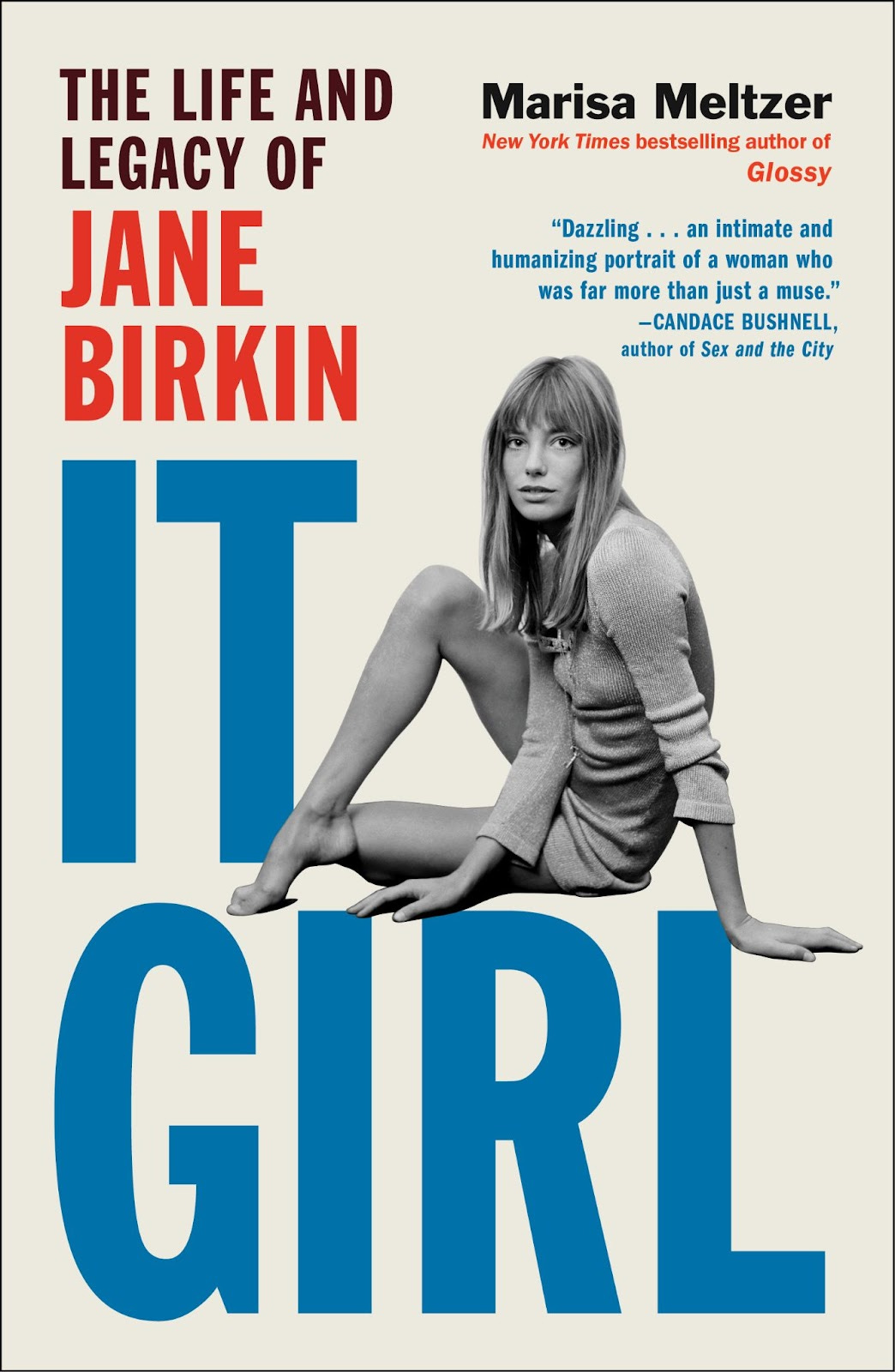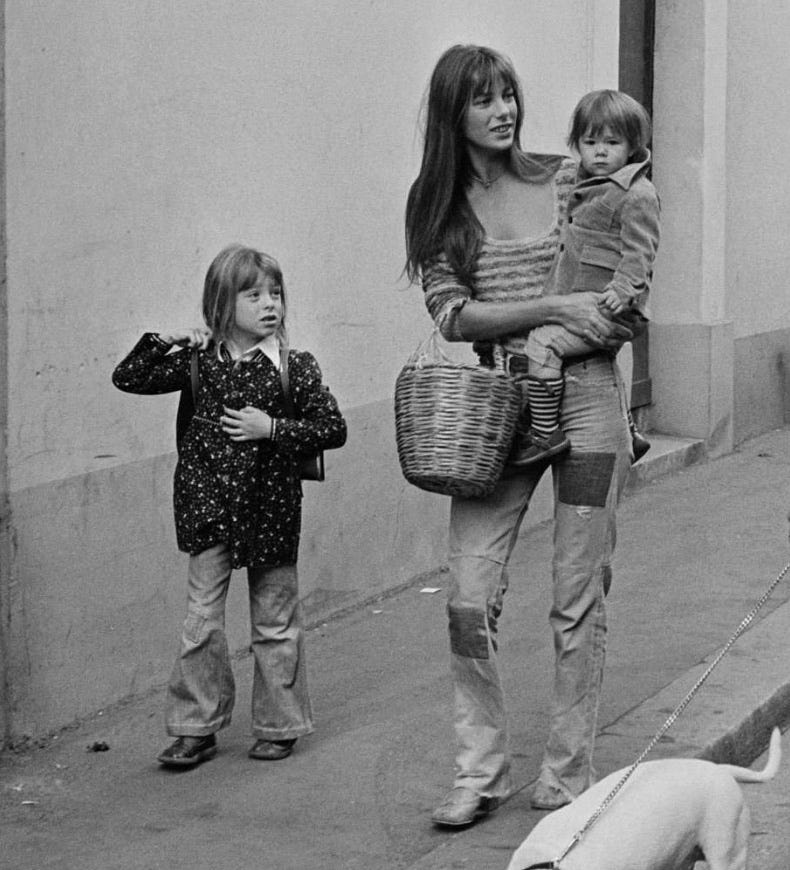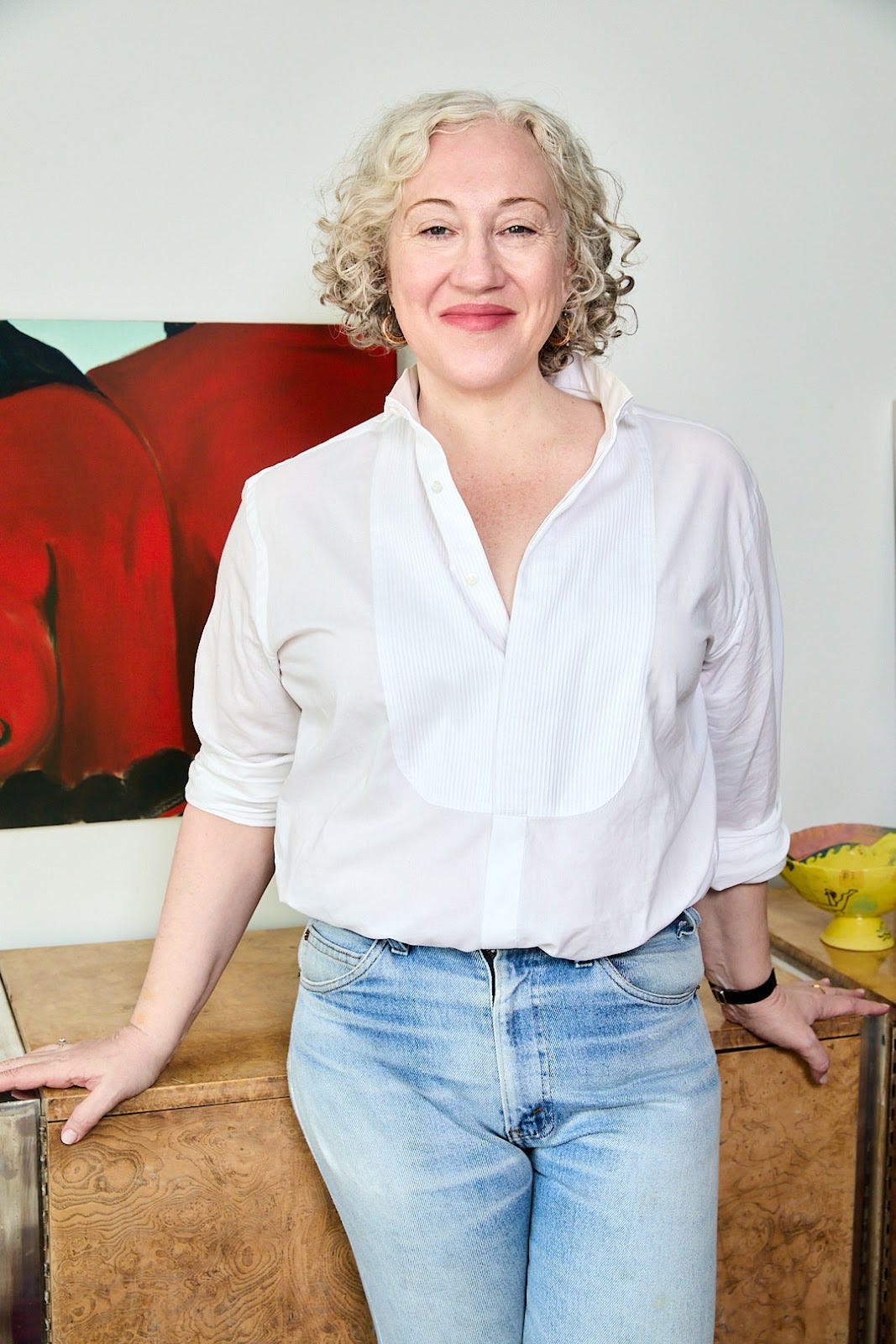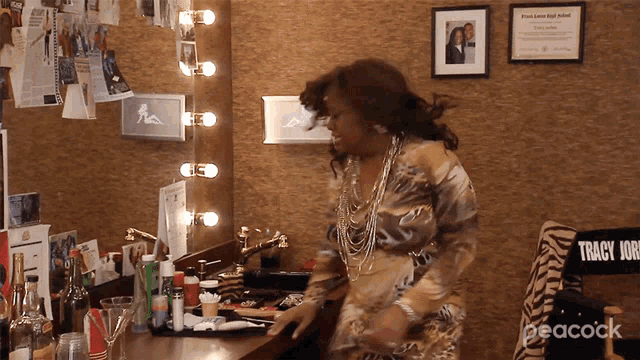Songs About Jane
The Eyre and Austen of newsletters is celebrating an It Girl with author Marisa Meltzer. Also: A Tashjian excluuuuusive! Plus: A Yalie on Yalies!
Welcome to Spreadlandia, where two veteran editors read it ALL to winnow out only the best: juicy yarns, big ideas, deeply personal essays, and hot goss—aka, the full Spread. Plus: original interviews, podcasts, and more. Come hungry!
Spreadizens,
Hope you brought your appetites this week because we’re here with an extra helping of media world fun: An interview with Marisa Meltzer, whose new book (her fifth!) was released just yesterday. It Girl, a biography of the one and only Jane Birkin, comes out a mere two years after the launch of Meltzer’s bestselling Glossier tell-all, Glossy; also, two years after Birkin’s death at the age of 76. In book years, twenty-four months is barely the time it takes to make yourself a cup of tea between procrastination breaks. But Marisa sold the proposal for It Girl even before Glossy came out, with only a week or two off between projects. “My personal life has probably suffered,” she told us, “in that I kind of don’t have one.” But look, in publishing, when the iron is hot—and Glossy was a big success—you strike. You can read the full New Yorker write up here, but in brief, what jumped out at us was young Birkin’s aching insecurity about her looks, of all things, proving once and for all that no human woman is immune. Also: the intimacy of the stories Marisa digs up (sex hotels with Serge, mkay?) thanks to Jane’s diaries, which date back to childhood, and which she later published (only one volume made it into English). This act strikes us as Birkin’s most dramatic rebellion against the two-dimensional image she was saddled with for most of her life. She knew there was more to “Jane Birkin” than a camera could see, and now It Girl readers will too.
Rachel & Maggie
Keep reading for our interview with Marisa…But first, the news!
We’ve been asked by some of you to “make sense of this Bari Weiss thing.”
By which you may mean: Weiss’s appointment as editor-in-chief of CBS News and Paramount’s1 $150 million acquisition of The Free Press, which she launched here on Substack a mere four years ago (right about when we did, but who’s counting) and which now has 1.5 million subscribers, 170,000 of them paid. How has this anti-woke center-right spark-lobber with no broadcast experience gained such power, so fast? MSNBC offers a great summation of the situation here. For what it’s worth, our hot and slightly unprofessional take is that, while Bari may photograph as a normal-looking 30-something, her greatest power may be the fact that, in person, she’s charisma incarnate. How did we glean this? Through her romantic history, of course. (Her partner Nellie Bowles has said, “I ended up falling in love the second I saw her.” She also dated Kate McKinnon in college.) Also because, perhaps more importantly, the second she gets introduced to a billionaire, he’s eating out of her hand and whipping out his checkbook. (Now there’s an online course we’d sign up for!)
Hot off the presses!
Here’s a move we never would have predicted, but find brilliant: Washington Post fashion critic Rachel Tashjian is off to CNN! We asked her what she’s envisioning for the job. Her swift and exuberant reply:
“Oh yes OF COURSE! Anything for my Spreaditors and Spreadikins!!
The history of fashion journalism was written through the moving image: Elsa Klensch and Jeanne Beker and Tim Blanks told the story of 20th- and early 21st-century fashion in real time with their on-air reporting. And today, so much fashion analysis and news happens on video and social media; it’s an amazing untapped platform for a news organization, especially one with an audience the size of CNN’s across video, broadcast, digital, and social (all of which I’ll be doing). I am most excited about this because it means more fashion coverage for more people.”
We will be sitting in front of CNN clicking refresh repeatedly until your dispatches appear, Rachel T. Thank you, goodnight, and good luck!
This Yale scammer is “the new Anna Delvey”...
Or so Air Mail would like us to believe. We asked our trusty intern, Miranda Wollen, a recent Yale grad—because only the best for the Spread!—to weigh in on the campus admissions scandal du jour.
“As a Yalie, I view Katherina Lynn as more of a Talented Mr. Ripley type. She falsified transcripts, recommendation letters, and her personal statement to get into a school that’s definitely not dealing with fakery for a first, or a second, or even a third time. Yale is not known for its well-adjusted student body or its eagle-eyed admissions team. (No comment on what this means about my recent matriculation.) But it’s the way Lynn was caught that makes this one juicy: After she allegedly threatened to bring her 30-year-old boyfriend back to her dorm room—which I can personally verify would have been about 9’x12’ on the generous side—for a little BDSM (“Sex-slave stuff,” one student noted), her suitemate, Sara Bashker, began snooping around in her stuff and found an ID with Lynn’s real name and home address. The scammer was sent packing. But even Bashker admitted, speaking for us all, “You have to recognize game.”
Read “She Faked Her Way into Yale. Then Things Unraveled” (also written by a Yalie!) here.
Hardly an Everywoman
Like everyone who spends any time in Brooklyn Heights, we’ve had enough run-ins with Keri Russell (and sometimes her boyfriend, Matthew Rhys)—on Henry St., in the movie-theater bathroom line, at the doctor’s office—to have constructed a full-on parasocial friendship with her (this atop our enduring, borderline fanfic-y relationships with Felicity Porter, Elizabeth Jennings, and Kate Wyler all). So when we saw that Emily Nussbaum had profiled Russell in this week’s New Yorker, we couldn’t wait to read about how she embodies all the qualities we’ve long projected upon her: smart, cool, low-key sexy. The pudding, however, proved that Russell is way smarter, cooler, and sexier than we’d ever dreamed—and not a lick actressy! What’s more: not only does Nussbaum witness her in sexy-cerebral dialogue with Rhys, she and Russell spend significant time hanging out in a Brooklyn-bar window seat while drinking beer and lots of Sancerre! Can we get a four-top next time, ladies? Season 3 of The Diplomat will hit Netflix on October 16.
Read “Keri Russell’s Emotional Transparency Has Anchored Three Decades of TV” here.
She Definitely Wasn’t For Sale
In the early 1960s, artist Lee Lozano was among SoHo’s most promising abstract painters. But by the back half of the decade, she traded that medium in her quest for a less commodifiable way to express herself: lists of ideas and outputs of whatever performance or lived experiment she was working on, in blocky handwriting, and wild drawings on notebook paper. By the early 1970s, she pivoted further: Her project, “Decide to Boycott Women,” was conceived as a temporary lived-art experiment but—tragically and triumphantly—became the rest of her life’s work. In T magazine, writer Sasha Weiss—close Spreaders know we never skip a Sasha Weiss joint—endeavors to capture the knotty and analytical mind of Lee in a posthumous profile, pegged to a book about her life and a survey of Lozano’s work at Hauser & Wirth in LA. Though Lozano died in 1999, Weiss succeeds in making the work relevant by reframing her as a prophet of sorts. “Lozano identified and anticipated so much that still troubles us: The commodification of the art market, the way social movements can curdle when they become too rigid, the self and self-fascination as the ultimate traps,” Weiss writes. “Other artists…are reclusive and ambivalent about subsuming their identities in the art market, but Lozano’s refusals were orchestrated with such commitment that they became works of art in themselves.”
Read “She Didn’t Speak to Other Women for 28 Years. What Did It Cost Her?” here.
Free Wendy
New York’s cover this week features Wendy Williams looking a little, uh, caught off guard. And, ya know what? Lady has a right to be on edge! The accompanying story by total pro Jessica Bennett is a deep-dive into the mess of conspiracy theories about and players surrounding Williams’s time in “luxury prison”—the schmantzy $25,000-per-month Hudson Yards assisted-living facility—where she’s been stuck since she was placed under court-appointed guardianship in 2022. According to Williams’s guardian, she has dementia and should not be able to make any decisions for herself; according to Williams herself, she is all there. Regardless, it’s a tragic situation, echoing Kerri Howley’s 2022 cover story for the same magazine on Britney Spears and the conservatorship she long battled. (FWIW, a conservatorship has legal control over one’s finances while a guardianship has legal control over everything.) The Williams story is mostly a competent write-around—you can just feel Bennett’s feet pounding the legal pavement—until, well, it’s not. A satisfying triumph of the “and then the phone rings” magazine-story genre!
But want to know what’s really worth the price of admission? The Williams chatter inspired us to go back a few weeks and read Sherri Shepherd’s lengthy Vulture interview with Shamira Ibrahim. Shepherd, who inherited The Wendy Williams show in 2022 (it’s now called Sherri) is truly a national treasure,2 and her warm and candid interview—about Friends, taking acting classes from Jeff Goldblum, Tracy Morgan’s exploding shark tank, The View, the Black comedy circuit, and so. much. more.—had us giggling at our laptops.
Read “Wendy Williams Wants Out” here.
Read “The People’s Bestie” (Sherri Shepherd) here.
“The most depressing thing I’ve read in a very long time.”
Thus spoke loyal Spreader Sarah, about the New York Times profile of Lemonheads frontman Evan Dando, timed to the release of his memoir, Rumors of My Demise. Sarah was so fired up—and we felt so dog-ate-my-homework around 9 a.m. today—that we outsourced this review to her capable mind: “I realized midway through that he’s clearly very, very unwell. By the end, I was disturbed by the reinforcement of the trope that the damaged male artist is somehow more interesting or complex. It felt like a sort of protection of him, or softening of what seems like a lot of harm he’s inflicted on others (and obviously himself). Would a piece about a similar woman (Florence Welch comes to mind, but I think she’s legit sober) extend the same grace? It seemed like this ‘he’s allowed to be messy’ vibe that women don’t get much of…maybe because women recognize how little there is to be gained from being messy!” Thank you for your service, gentle (and brilliant) reader.
Read “Evan Dando Is Back from the Brink” here.
All we can think about right now is what it’s like to be Maya Rudolph and Paul Thomas Anderson
It took 35 minutes of neck yoga for one of your Spreaditors to peel her shoulders away from her ears after seeing PTA’s One Battle After Another last night—such was the level of stress induced by sitting through two and a half hours of not just highly suspenseful filmmaking but also some of the most explicitly racist Ku Klux Klan-level dialogue we’ve seen on screen.3 All of it written and directed, of course, by the father of four mixed-race kids. Anderson has said he first started writing a draft of the script 20 years ago, after the birth of their first daughter. Now, just try to watch the beautiful teenage daughter played by Chase Infiniti without your mind wandering to the Rudolph-Anderson brood. Afterward, you’re going to need to take a load off with Rudolph’s Loot, back this month and not a moment too soon. That bounty of creativity, and the contrast between their output, is fas-ci-nat-ing! Paul, Maya—are you open to adopting two gently aged (but mint condition!) magazine editors?
Read “OBAA is Paul Thomas Anderson’s Most Personal Film” in GQ here.
And now, without further ado… Introducing It Girl author Marisa Meltzer!
The Spread: Okay Marisa, tell us about living the ultimate writer’s fantasy—spending months in Paris to research a book.
Marisa Meltzer: I knew I’d have to go to Paris for at least a month. Then I found out the building I was living in in New York was going up for sale. Rather than immediately find a new apartment, I thought, okay, I’m just putting my stuff in storage and going to France for a couple months. I’ve spent a lot of time in Paris—I’ve done and seen enough that now I can kind of relax there. If anything, I can be a little unambitious as a traveler. I just want to have long lunches. It was winter, and I went to some really fun Christmas parties. I brought my dog, which was very fun—going to French dog parks. A lot of my daily walks would just be me and my dog walking along the Seine on a Tuesday. But I also worked all the time. I remember taking notes on Christmas Day, frantically trying to do as much as I could fit in.
Spread: Jane’s original Birkin Bag—famously designed for her after she shared a flight with the CEO of Hermès—sold for $10.1 million in July. It was the most valuable handbag ever sold, and the Birkin is one of our most recognizable status symbols. Everything that it represents in our culture today seems like the antithesis of the bohemian Jane, though.
MM: The bag’s reputation has grown and become its own thing, very much apart from Jane Birkin. It’s really just the name. She didn’t model the bag or really have anything to do with [promoting] it, which I think is kind of cool—I think she saw the bag as something “other.” On the other hand, I’ve watched TikToks where people say, “Jane Birkin hated the bag,” which absolutely was not true. She got them for free. I think she had five over the course of her life. She totally carried them and seemed to really like them, and she went to Hermès shows. But she just had a completely different relationship with the bag than anyone else.
The Spread: The Birkin wasn’t “the Birkin” in her day, right?
MM: It was introduced in the mid-’80s. You start seeing pictures of famous people with it in the late ’90s, like Carolyn Bessette-Kennedy, and then into Sex and the City and Gilmore Girls and all of that. It took a really long time for it to become famous, and then it became something that’s in music lyrics, and Melania Trump is carrying one and all the Kardashians and Real Housewives. It took almost 40 years for it to get to where it is now. But I can’t imagine what it’s like to have your name completely divorced from you like that.
Spread: So much myth-making happened around Jane. For starters, she wasn’t even French—she was English.
MM: Paris has this history of taking foreigners and making them into French people—Marie Antoinette, Anna Karina the actress, Jane Birkin, Jean Seberg, Josephine Baker. It shows what a myth the “French Girl” is, particularly this idea of the Parisian in hand-me-down Chanel who’s thin and aristocratic. That idea was sold to the rest of the world, probably by luxury companies. It’s no surprise that the two richest men in France, and the world, own luxury conglomerates. That’s one of the biggest industries in France, and it’s a crafted image.
Spread: So can we consider her French?
MM: I think she brought something to the Frenchness—maybe that kind of London look, vintage clothes and messy hair. France was a little bit behind England and the US when it came to the ’60s youth explosion. She came in 1968 to France and never left; that was also the year of the May student riots, the year that counterculture and youth culture solidified in France. So it was also a timing thing. But yes, she was a Parisian. She lived there for 55 years. And Paris is a city, kind of like New York, where you can be a famous person but you can also just go to your local café. She was very of the city.
Spread: This is your fifth book. Does that mean you’ve learned how to go through this process with less neurosis?
MM: It’s like anything else—the more you do something, the more you see the patterns. It’s like heartbreak, where you think you’ll never be the same: There’s always a phase where I think, this is not good and I don’t think it’s going to get better. Then I come out of it; I figure something out or maybe an edit cracks something open. At least now I recognize it as something that I do every time.
The Spread: Now you’re on Substack, too, with
, and you’re still publishing freelance pieces. How does the plate-spinning work?Marisa Meltzer: I’m pretty type A, so I’m good at just planning things out. And I’m not married and I don’t have kids, so I don’t have to negotiate [around those things]. But it’s a different ecosystem now. There used to be, just in terms of teen magazines alone, Teen Vogue, ELLEgirl, CosmoGirl, Teen People. You could make a living more or less just writing for those sorts of magazines. Now I think all but Teen Vogue and Seventeen are gone. So there are just fewer publications. Stories are shorter, budgets are tighter. The idea that someone is going to get assigned a cover story and it’s going to pay $9,000—it doesn’t much exist anymore.
Thank you, Marisa! Not to be bossy but everybody go buy It Girl here, and sign up for
while you’re at it.Did someone forward you this email? To get the full Spread with all the fixins every week, click here to get that 25% off anniversary-rate paid subscription.
One question that keeps bouncing around our brains as Larry Ellison and his son, David, continue their quest for total media domination: As David, a one-time proud Dem, has increasingly gone the way of UFC fights and Elon Musk meet-ups, what of Megan Ellison, the gay and very press-avoidant daughter, founder of Annapurna Pictures (and recipient of $1.8 billion from dad to fund her Hollywood dreams), who has backed such Spready, left-leaning fare as Zero Dark Thirty, Her, Phantom Thread? She made Nightbitch, people! There’s no way she is cool with this. Vanity Fair editors: Can we get an investigation on the Murdochian dynamics within this family empire? She’ll never give an interview but surely the people around her will talk!
Further musings from OBAA: Somebody do a beauty story on Tony Goldwyn, please. The man does not age.






The mind reels imagining what Rachel will dream up at the new gig. And so excited to read the Birkin book!